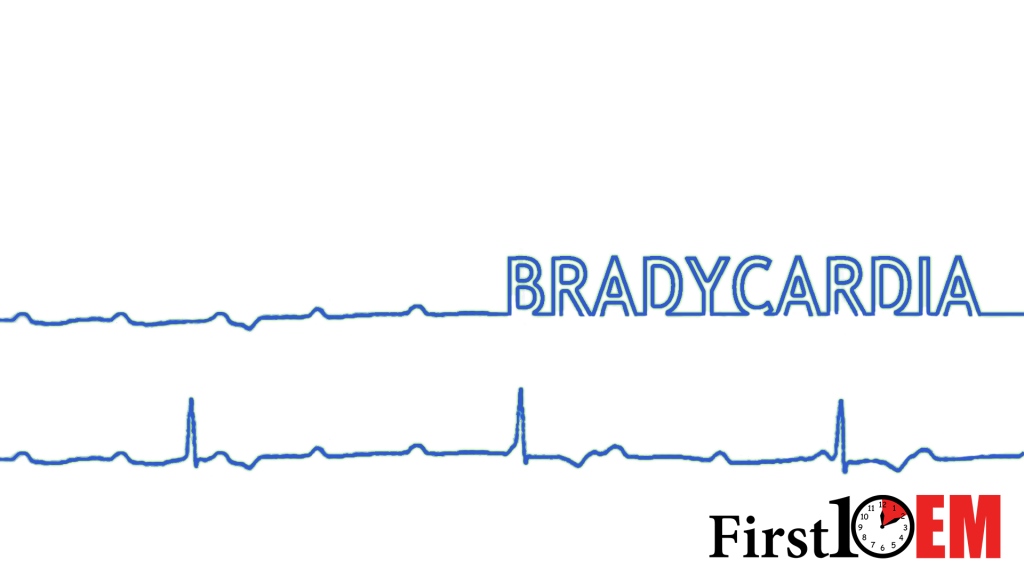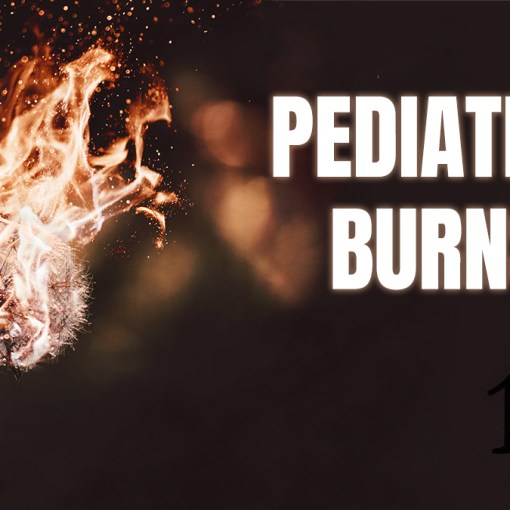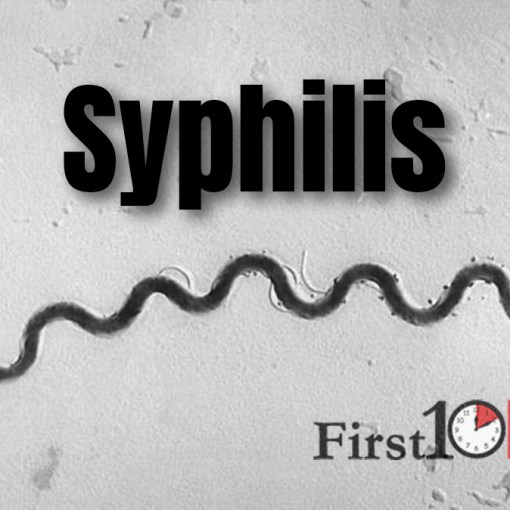Morgenstern, J. Managing unstable bradycardia, First10EM, September 19, 2016. Available at:
https://doi.org/10.51684/FIRS.2701
Case
A 67 year old man is brought in by EMS after a syncopal episode at home. He has only partially regained consciousness, with a GCS of 12. His wife says that he has had a fast heart rate before and that he also has diabetes and high blood pressure. She isn’t sure what medications he is on. He has had flu like symptoms for a few days. The paramedic vital signs were a heart rate of 38, a blood pressure of 69/45, a respiratory rate of 22. The oxygen saturation tracing has been inconsistent, but they think it is probably about 91% on room air…
My approach
Just like every other time I step into the resuscitation room, my first thoughts are the ABCs. In bradycardic patients, immediate and effective management of airway and breathing is essential, because hypoxia is a potential cause of bradycardia.1,2 However, airway management in the setting of cardiogenic shock is fraught with difficulty. Essentially all the medications we use in RSI depress cardiac function and can directly lower blood pressure. The transition to positive pressure ventilation also negatively impacts hemodynamics.3 I start with basic airway maneuvers. For me, this means 2 nasal airways, elevating the head of the bed to 30 degrees, applying a jaw thrust, holding a good seal with a BVM with attached PEEP valve, and monitoring ventilation using quantitative waveform capnography. Ideally, these maneuvers will temporise the airway and breathing until I can adequately resuscitate the patient, making RSI safer. However, if I cannot confirm adequate ventilation with waveform capnography, I will intubate.
A lead 12 ECG is important for a formal diagnosis, but in the truly unstable patient it is often necessary to start treatment immediately, based on the rhythm on the cardiac monitor.
Vascular access is essential. If an IV cannot be obtained within 60 seconds, I will place an IO.2
Key step 1: Temporarily increase the heart rate
This can be done either pharmacologically (using dopamine or epinephrine) or electrically (starting with transcutaneous pacing).1 In the past, I was confused about the order in which these interventions should be tried. My approach now is simple: start both at the same time. Transcutaneous pacing frequently fails and is not a long term solution, so starting a chronotropic medication right away makes sense. However, it takes time to get a drip started and titrated to effect, so an early attempt at transcutaneous pacing is important. Arranging the team so that both of these interventions are implemented in parallel rather than in series makes sense.
Dopamine 2-20 mcg/kg/min1
What is the role of atropine? I don’t know. Some people have very strong opinions about atropine. Personally, I will push it while the pacer pads are being placed and other medications are being drawn up, but only if it is immediately available and doesn’t not delay any other intervention. Realistically, though, atropine rarely works and is too short lived to be the sole therapy. Also, atropine is relatively contra-indicated in ischemia and second degree heart block.2
Key step 2: Consider and treat the underlying cause
In the initial minutes, the key diagnoses to consider in a sick bradycardic patient are:
- Electrolytes: The big one that you don’t want to miss is hyperkalemia. Pacing is unlikely to help unless you manage the potassium. Review the management of severe hyperkalemia here. If you haven’t already ready it, I would also suggest reviewing the PulmCrit post on BRASH syndrome.
 Toxicologic: Medications are a common cause of bradycardia and some require specific therapies that go beyond the ACLS algorithm:
Toxicologic: Medications are a common cause of bradycardia and some require specific therapies that go beyond the ACLS algorithm:
- Digoxin: digibind
- Calcium channel blockers: calcium gluconate, high dose insulin
- Beta blockers: glucagon, high dose insulin
- Organophosphates: atropine, pralidoxime
- Opioids: naloxone
- MI/ACS: Although many different intrinsic heart diseases can result in bradycardia, ischemia is the one to consider immediately, as the patient might need the cath lab
- The mnemonic to remember these etiologies is: don’t let your bradycardic patients D.I.E. – drugs, ischemia, electrolytes. (I think this is from Mel Herbert, but I am not sure.)
I will arrange for emergent transvenous pacing as soon as possible (generally immediately after starting epinephrine, transcutaneous pacing, and quickly considering the underlying cause).1 Depending on the department I am working in, this might mean calling cardiology or gathering the supplies so that I can place the pacer myself.
If dopamine or epinephrine don’t work as single agents, my next step is to use both. If there is no response to both dopamine and epinephrine, I start isoproterenol.
Notes
AHA 2010 Bradycardia algorithm:

The expanded differential diagnosis of bradycardia:
- Cardiac disease
- MI/ACS
- Myocarditis
- Cardiomyopathy
- Infiltrative disorders (amyloidosis, sarcoidosis)
- Metabolic
- Electrolytes
- Hypothyroidism
- Hypothermia
- Hypoglycemia
- Drugs
- Digoxin
- Beta-blockers
- Calcium channel blockers
- Clonidine
- Organophosphates
- Amiodarone
- Opioids
- Hypoxia
- Raised intracranial pressure
- Infectious (lyme disease, syphilis)
- Physiologic/ vagal stimuli
Other FOAMed Resources
BRASH syndrome: Bradycardia, Renal failure, Av blocker, Shock, Hyperkalemia on PulmCrit
In case that is too much serious learning for you, you should definitely watch “Diagnosis Wenckebach” by the University of Alberta medical class of 2010:
References
- Neumar RW, Otto CW, Link MS et al. Part 8: Adult Advanced Cardiovascular Life Support: 2010 American Heart Association Guidelines for Cardiopulmonary Resuscitation and Emergency Cardiovascular Care. Circulation. 122(18_suppl_3):S729-S767. 2010. [free full text]
- Stahmer SA. Chapter 58. Bradyarrhythmias. In: Adams, JG et al. Emergency Medicine Clinical Essentials, 2e. Philadelphia,PA: Elsevier; 2013.
- Mosier JM, Joshi R, Hypes C, Pacheco G, Valenzuela T, Sakles JC. The Physiologically Difficult Airway. The western journal of emergency medicine. 16(7):1109-17. 2015. PMID: 26759664 [free full text]
Morgenstern, J. Managing unstable bradycardia, First10EM, September 19, 2016. Available at:
https://doi.org/10.51684/FIRS.2701






12 thoughts on “Managing unstable bradycardia”
Great review
I discussed a case of bradycardia with Swami on “Lessons podcast just this week
Synchronised posting!
Nice
Our cardiology department takes Isoproterenol as the first choice. What is your take on that?
Thanks for the comment.
Isoproterenol is an excellent choice to get the heart rate up. However, if the patient is not hypotensive they probably don’t need treatment. If the patient is hypotensive, I want an agent that will address the pressure as well as the heart rate, like epinephrine. Isoproterenol might improve the pressure by improving the heart rate, but it could also lower the pressure.
So only yesterday I had a 78 year old woman present in 3rd degree block and bigeminy, with witnessed R on T events leading to short Torsades bursts and syncope. Gave Mg, and really wanted to get a transvenous pacer in, but was informed the hospital does not have the set-up any more. She was hypertensive, about 190/95, so I didn’t want to give epi or dopamine, and she was wide awake between syncopal events, so overdrive pacing transcutaneously was less palatable. Discussed the case with our intensivist, and ended up using isoproterenol to temporize for the transfer. Fairly unusual case, but here’s a good use for the drug. Maybe a cool case for higher level sim?
Great post! I got the idea for D.I.E. from a differential Mel Herbert once put together in a lecture but (I think) the acronym may be my own invention. Anyway, I only say that because I’ve since updated it to include hypothyroidism (http://www.ems12lead.com/2015/12/27/12-rhythms-of-christmas-sinus-brady/) after almost missing the diagnosis twice in a couple of months (Don’t let the underlying cause HIDE). It’s not as fun as DIE but missing hypothyroidism is less fun.